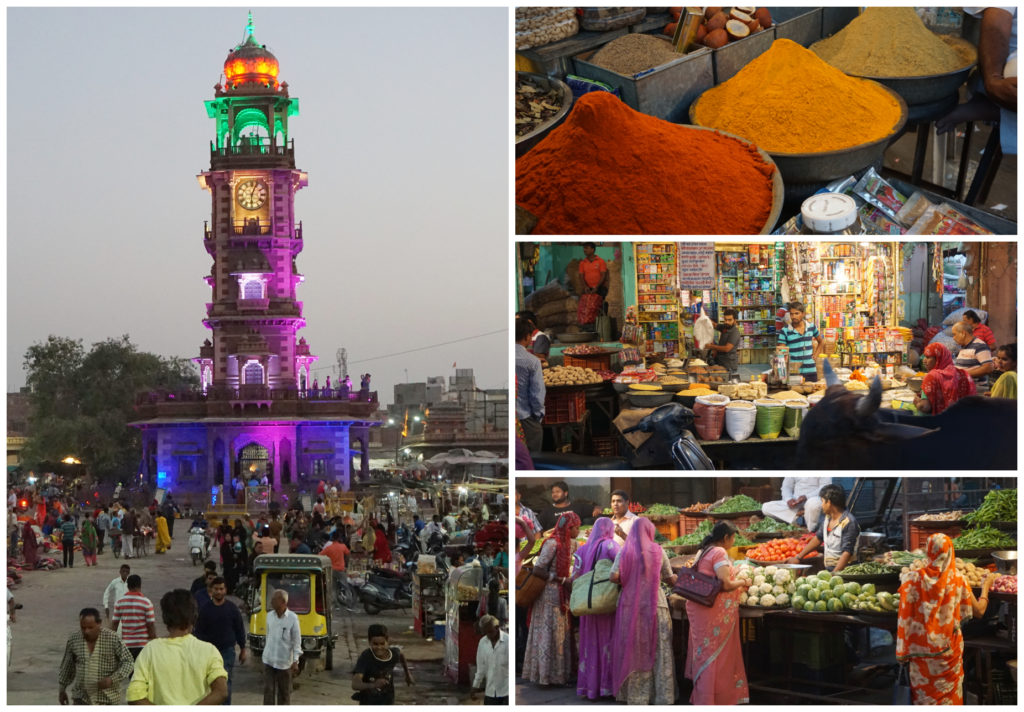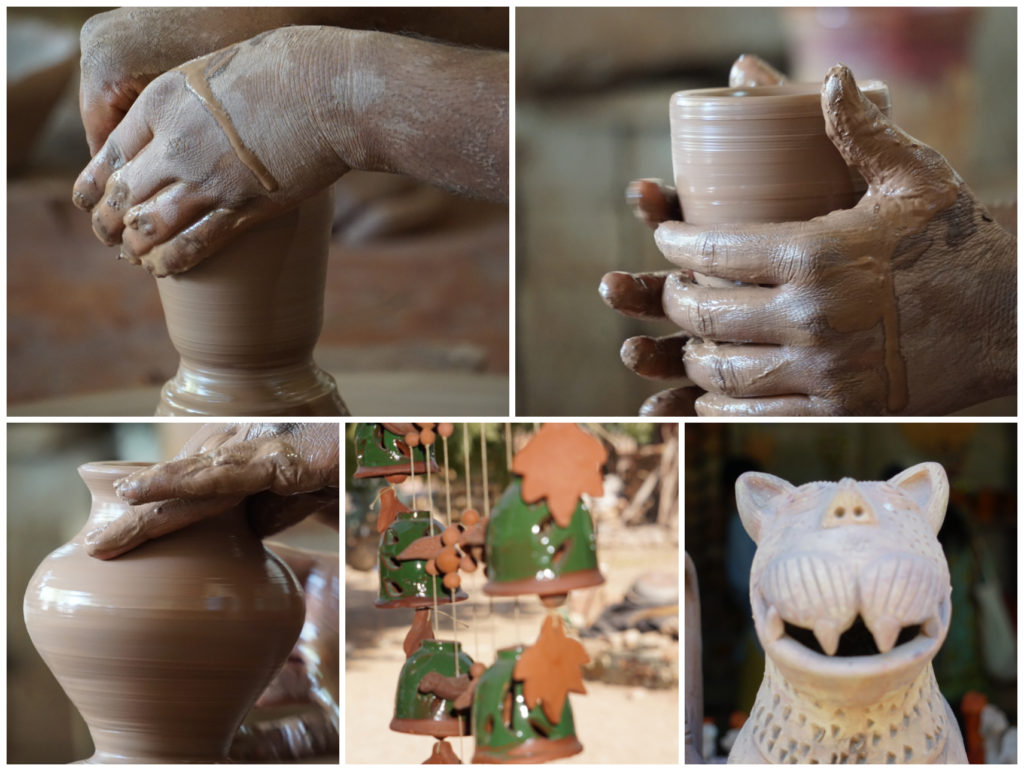It was time to leave Jaisalmer for a 6-hour train ride (3rd class, a/c), which took us across the desert towards Jodhpur, known as The Blue City.
City Wandering
Surprisingly, the train arrived on time, albeit a tad early. As expected it was pretty chaotic on the platform. We jostled our way with packs in tow, towards our bevvy of jeeps for our transfer to our accommodation.
We were pleasantly surprised with Jagat Villas Home Stay.
Although classed as a Home Stay, it was a suitably sized guest house with comfortable beds and a substantially sized communal eating area.
The establishment was originally part of the Rai Ka Bagh Palace and its primary role was the Headquarters for the Royal Guards.
I didn’t get to see who was doing the cooking but the prepared authentic buffet lunch was most welcoming after our long train trip.
Fort Mehrangarh
With our stomachs full, we boarded our mini-bus to travel a short distance to Fort Mehrangarh.

The imposing walls of the fort, looming over the city
I was taken aback when I saw its burnished red sandstone. It made it look quite imposing and invincible. The sheer height alone makes it one of the most impressive looking forts in Rajasthan. It stands 125m above the city. Thick stone walls fully enclose the fort.

It was fascinating learning about the history of the ancient walled city
There is a winding road which leads up to one of its seven gates. It is fascinating to see the imprints of the cannonballs from battles of years gone by, well since 1459 when the fort was built. Today, it is one of the best-preserved forts in India.
We donned audio guides and walked around the fort complex along with hundreds of mainly local tourists.
The Blue or Sun City
Jodhpur is referred to as The Blue City or Sun City. It’s pretty obvious why once we got to explore a little more of the city.
The second largest city in Rajasthan, the city has expanded along the walls of the historic walled old city for approximately 10kms.

Spotting the blue buildings which dotted the cityscape
A blue pigment coating on a house used to indicate that a Brahmin (the priests of the Indian caste system) lived there. Over time the colour became an identity for non-Brahmins too. The colour also repels insects. This would come in very handy seeing that the city is located right on the edge of the Thar Desert.
Jodphur’s proximity to the Thar Desert is why it is called the Sun City. It has an overwhelming amount of bright and sunny days. The time we spend there was no different as the sun poured down on us for the two days we spent there.
So Much More in Jodphur
The city is well renown for its textile industry, furniture shops, outstanding cuisine and bustling bazaars since being established over 500 years ago.

The clock tower lights up in the evening, adding to the already vibrant colours of the spices and materials
We wandered around the markets surrounding the clock tower and stopped off at a local eatery for some Halwa, puri (fried bread), dal Ka Halwa (all for $1nz).

Our delicious and cheap dinner and how many can you squeeze into a tuk-tuk – we counted 9 plus shopping!!!
The popular traditional Lassi originated in Jodphur. Lassie is a yogurt based drink that blends yoghurt, water, spices and sometimes fruit. Different varieties include savoury (flavoured with ground and roasted cumin), salty and sweet. A nice cooling mango lassi went down well to help combat the heat.
Bishnoi Village Visit
The next morning, it was back into the jeeps to visit one of the Bishnoi Villages. It’s approximately 20km from the city.

The people of Bishnoi are nature lovers and are very keen to protect all things nature. They live an incredibly simple life in houses called Dhani.
What You Can Do With Cow Dung
The small huts have thatched roofs and constructed using cow dung. It’s plastered on the floors and walls. Cooking fires are fueled by cow dung. The hamlets were spotlessly clean. The floors swept clean. All bedding and clothing neatly stacked in corners.

Making chapati the hard way and cooking it on cow dung-fueled fires
We watched how they hand-grind the millet for their chapati’s and some of us had a go at cooking them over the cow dung open firepit.

The colourful women of the villages
The villagers were very welcoming, friendly and enjoyed their western visitors. I have no doubt that the tourist industry is pivotal in the survival of these people.

tourism at work, crucial in the survival of these villages
The locals dress in clothes designed to bear the hot weather. Men wear white dhoti, shirt and colourful turbans. Married women often wear large circular nose-rings and heavy bracelets and anklets.
Pottery

You can see the villagers creating amazing shapes out of a mere lump of clay
Numerous places in the area produce high amounts of pottery. The local red clay makes for some impressive pieces. Pottery is a popular form of income for many families.
Durries
There are many villages around the area where they weave beautiful carpets (Durries).

Jodhpur is famous for durries (rugs)
We visited the owner of one of the most popular durry manufacturing industries in the area. He employs numerous locals (mainly women) to weave the impressive rugs. It was very tempting to purchase some of his wares as he would kindly arrange postage to anywhere in the world! There were a few in the group who are now sporting some rather impressive rugs at home.
We were ready for our lunch at a local village. This was really back to basics. We watched them cook up a vegetarian spread over the cow dung fires. It tasted divine as we ate with our fingers, crosslegged on the durries.

who needs modern day appliances?

Great post which took me back to Jodhpur – I have some great textiles in my house from there! You had some wonderful experiences, I admire you for all the adventurous things you did and how you survived the train journey then went on to do more sightseeing!
Thanks again for a great post. I’m interested in travelling to India, yet I’ve heard people either love or hate it. Your pics look awesome & I loved reading all about Jodhpur. Everything is so colourful, and so different. It looks like your experiences were really diverse, even learning what you can do with cow dung 🙂 This post certainly has me thinking more about visiting India.